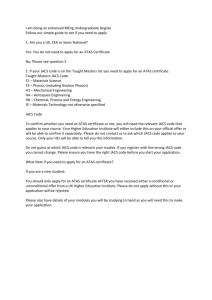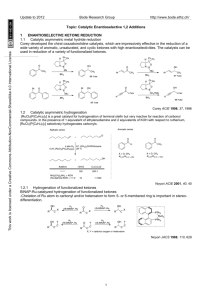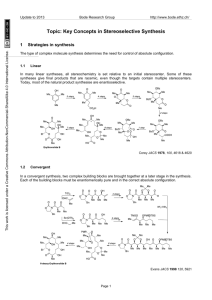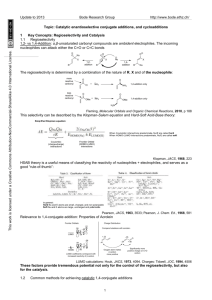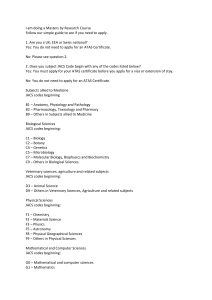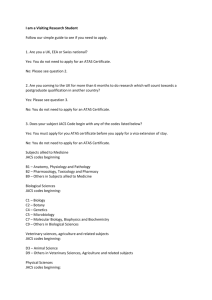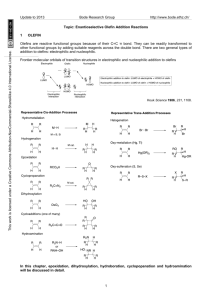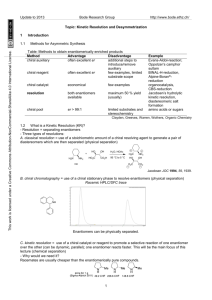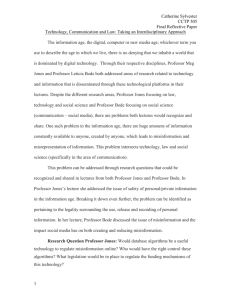Word
advertisement
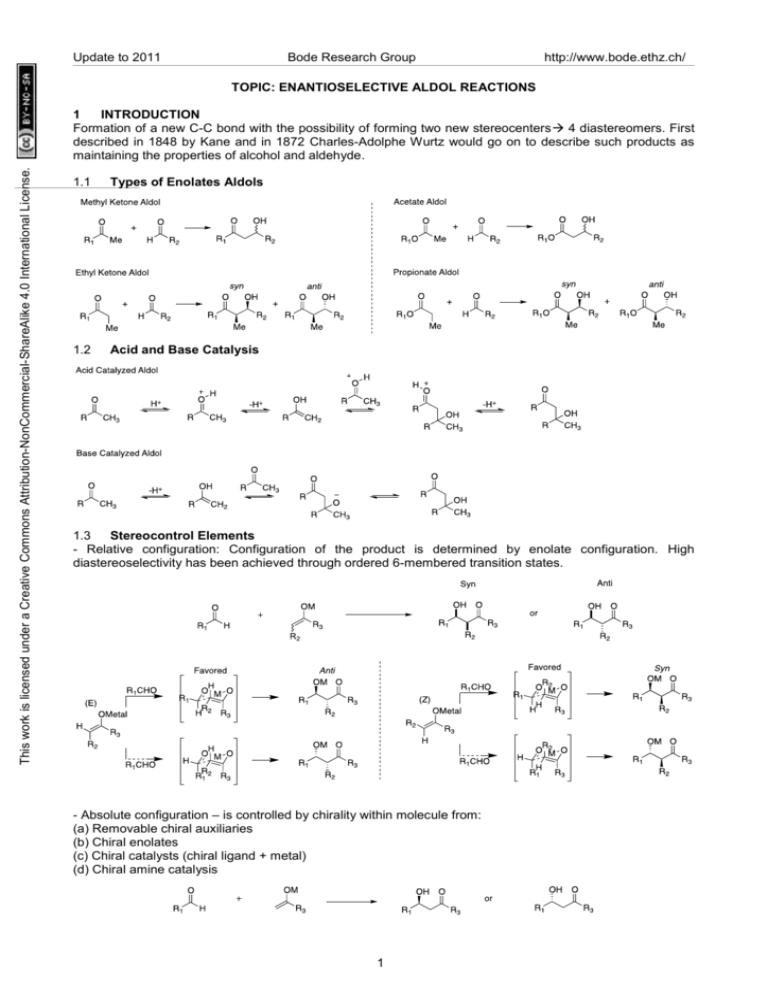
Update to 2011 Bode Research Group http://www.bode.ethz.ch/ TOPIC: ENANTIOSELECTIVE ALDOL REACTIONS This work is licensed under a Creative Commons Attribution-NonCommercial-ShareAlike 4.0 International License. 1 INTRODUCTION Formation of a new C-C bond with the possibility of forming two new stereocenters 4 diastereomers. First described in 1848 by Kane and in 1872 Charles-Adolphe Wurtz would go on to describe such products as maintaining the properties of alcohol and aldehyde. 1.1 Types of Enolates Aldols 1.2 Acid and Base Catalysis 1.3 Stereocontrol Elements - Relative configuration: Configuration of the product is determined by enolate configuration. High diastereoselectivity has been achieved through ordered 6-membered transition states. - Absolute configuration – is controlled by chirality within molecule from: (a) Removable chiral auxiliaries (b) Chiral enolates (c) Chiral catalysts (chiral ligand + metal) (d) Chiral amine catalysis 1 Update to 2011 Bode Research Group http://www.bode.ethz.ch/ This work is licensed under a Creative Commons Attribution-NonCommercial-ShareAlike 4.0 International License. 2 CHIRAL AUXILIARIES 2.1 Diastereoselective Control Syn Evans’ Oxazolidinones: Highly selective towards Z enolates. High diastereoselectivity to yield a single Syn product. Sterics often dominate the most preferred transition state. Evans, JACS 1981, 103, 2127 Effective only for chelating aldehydes. The second equivalent of titanium is necessary for the diastereoselective control. Chelation overrides steric control, but less as chelating group is further away from carbonyl. Ghosh, TL ,1997, 38, 7171 2.2 Diastereoselective Control Anti Anti diastereoselectivity is achieved for the aryl sulfonamide indanyls when using one equivalent of titatanium. O p-Tol O S O NH TiCl4 (1 equiv), i-Pr2NEt O p-Tol O S O NH i-BuCHO OTiCl3 p-Tol S O NH O OH 83-92% yield O O OBn O R 1-3 R R1 O Cl3Ti O R 99:1 dr R=alkyl, phenyll R O N TiCl2 S O Proposed TS O Me Ghosh, TL ,1997, 38, 7171 Evans found that the generation of magnesium enolates with the oxazolidinone auxiliaries would give anti adducts. A closed TS that does not follow the Zimmerman Traxler model is thought to be prevalent. TMSCl does not catalyze the reaction but quenches the aldol adduct. Evans, JACS , 2002, 124, 394 2 This work is licensed under a Creative Commons Attribution-NonCommercial-ShareAlike 4.0 International License. Update to 2011 Bode Research Group http://www.bode.ethz.ch/ 2.3 Asymmetric Propionate Aldols Syn With the use of 2 equivalents of titanium, a non-Evans is achieved. The second equivalent of titanium is thought to abstract a chloride that allows chelation to the thiazolidinethione. Crimmins JACS, 1997, 119, 7883 2.4 Asymmetric Propionate Aldols Anti Norephedrines as auxiliaries- E-enolates are selectively formed and yield the anti products via six-membered TS. Abiko JOC, 2002, 67, 5250 A chelating substituent on the enolate provides a different mechanistic pathway for the thiazolidinethiones. Z enolate is formed but the anti product is obtained with the use of two equivalents of titanium. S O O N 1. TiCl4 (1 equiv) Sparteine 2. RCHO Bn S O Ti O S O N H Bn O OH R H O Ti O 61-84% yield N R O Bn 87:13 dr R=alkyl Crimmins OL, 2003, 5, 591 2.5 Asymmetric Acetate Aldols Asymmetric control with acetates is more challenging than with propionates. Increased bulk of thiazolidinethione auxiliary allows for moderate to high diastereoselectivity. This is not possible with Evans’ oxazoldinone auxiliaries. Phillips OL, 2002, 4, 2253 3 This work is licensed under a Creative Commons Attribution-NonCommercial-ShareAlike 4.0 International License. Update to 2011 Bode Research Group http://www.bode.ethz.ch/ 3 CHIRAL BORON ENOLATES Enol Boronates Zsyn aldol and E anti aldol. With the use of chiral alkyl boronates, moderate enantioselectivity can be afforded. Paterson Tetrahedron, 1990, 46, 4663 4 MUKAIYAMA ALDOL REACTION 4.1 Background and Mechanism The crossed aldol reaction between a silyl enolate and a carbonyl compound in the presence of Lewis acid is referred to as a Mukaiyama aldol reaction. Mukaiyama Chem. Lett. 1973, 1011 Mechanism: - Diastereoselection. - Stereochemical outcome is explained by open-transition model, based on steric- and dipolar effects. 4 This work is licensed under a Creative Commons Attribution-NonCommercial-ShareAlike 4.0 International License. Update to 2011 Bode Research Group http://www.bode.ethz.ch/ Mahrwald Chem. Rev. 1999, 99, 1095-1120 4.2 Challenges to Metal Catalytic Enantioselective Mukaiyama Aldol Addition - Background silyl-catalyzed achiral aldol addition Carreira Tetrahedron Letters 1994, 35, 4323-4326 Bosnich JACS 1995, 117, 4570-4581 - Anti vs Syn (in aldol reaction with substituted silyl enolates) 4.3 Historic enantioselective Mukaiyama aldol addition The first enantioselective catalytic Mukaiyama aldol addition Mukaiyama, Kobayashi Chem. Lett. 1990, 129, 1455 Synthetic route to monosaccharides from achiral compounds Kobayashi Synlett 1993, 911 Guidelines for designing more recent catalysts: (1) Ligands with electron donors. (2) Stabilizing aromatic stacking interactions. (3) Reaction conditions minimize the silyl-catalyzed achiral aldol addition. 5 This work is licensed under a Creative Commons Attribution-NonCommercial-ShareAlike 4.0 International License. Update to 2011 Bode Research Group http://www.bode.ethz.ch/ 4.4 Silyl ketene acetals, thioester-derived silyl ketene acetals as nucleophiles 4.4.1 Syn - Chiral (acyloxy)borane (CAB) complexes of tartrate-derived ligands by Yamamoto Yamamoto Synlett 1991, 439 ,-Unsaturated aldehydes reveal excellent diastereo- and enantioselective due to the π interaction. Reaction with aliphatic aldehyde resulted in slight reduction of optical and chemical yields. 4.4.2 Anti - Chiral BINOL and Zr(IV) complexes by Kobayashi Kobayashi JACS 2000, 122, 5403 Kobayashi JACS 2002, 124, 3292 Synthesis of Khafrefungin Kobayashi JOC 2001, 66, 5580 6 This work is licensed under a Creative Commons Attribution-NonCommercial-ShareAlike 4.0 International License. Update to 2011 Bode Research Group http://www.bode.ethz.ch/ 4.4.3 Acetate Mukaiyama aldol addition Like chiral auxiliaries, metal catalysts have also had difficulties in obtaining high enantioselectivity in acetate aldol additions (acetate derived nucleophiles). - Chiral oxazaborolidine complex generated from C-alkylated -amino acids by Masamune Masamune JACS 1991, 113, 9365 - BINOL and Ti(IV) complexes by Keck and Mikami BINOL/TiClx(OTf)y catalyzes acetate aldol addition with excellent yields and enantioselectivity. Broad scope of aldehydes including simple aldehydes and functionalized aldehydes such as trifluoroacetadehyde, chloroacetaldehyde, benzyloxyacetaldehyde, ethyl glycolate… Mikami JACS 1993, 115, 7039, JACS 1994, 116, 4077 & Synlett 1995, 1057 - Complex of Ti(IV), tridentate Schiff base and di tert-butylsalicylic acid by Carreira Carreira JACS 1994, 116, 8837 Carreira, Kvaerno Classics in stereoselective synthesis p.133-134 7 This work is licensed under a Creative Commons Attribution-NonCommercial-ShareAlike 4.0 International License. Update to 2011 Synthesis of Phorboxazole A Bode Research Group http://www.bode.ethz.ch/ Smith JACS 2001, 123, 10942 - Complex of chiral Bis(oxazolidine) (BOX) or bis(oxazoline) (PYBOX) and metals by Evans Evans JACS 2000, 122, 10033 Evans ACIE 1997, 36, 2744 2.4.4 Ketones as electrophiles - Evans developed a family of chiral bis(oxazolidine) (BOX) and bis(oxazoline) (PYBOX) complexing with different metals as catalysts for enantioselective Mukaiyama aldol addition. Diverse stereo outcomes can be obtained based on the metal and ligand used in the complex. Bidentate chelation leads to the formation of a square pyramidal complex and the re aldehyde enantioface is shielded -> High level of diastereoselectivity and enantioselectivity. The requirement of chelation limits the scope of electrophiles ( -alkoxyacetaldehydes, pyruvates, glycolates, -diketones, 5-formyloxazoles). Broad range of nucleophiles: thioester-derived ketene acetals, ketene acetals, ketone-derived enolates. Chiral Bis(oxazolidine) (BOX) or bis(oxazoline) (PYBOX) and Cu(II) complexes Evans JACS 1997, 119, 7893 8 This work is licensed under a Creative Commons Attribution-NonCommercial-ShareAlike 4.0 International License. Update to 2011 Bode Research Group Chiral Bis(oxazolidine) (BOX) or bis(oxazoline) (PYBOX) and tin(II) http://www.bode.ethz.ch/ Evans JACS 1997, 119, 10859 Chiral Bis(oxazolidine) (BOX) or bis(oxazoline) (PYBOX) and scandium(III) Evans OL 2002, 4. 3379 - Complex of Cu(I)fluoride and chiral Taniaphos ligand by Shibasaki Examples of effective catalyzed enantioselective aldol addition involving simple ketone acceptors are scarce due to the attenuated reactivity of ketones and reversibity of their aldol addition. Stereocontrol is also challenging. Shibasaki JACS 2006, 128, 7164 4.5 Enol ethers as nucleophiles 4.5.1 Syn - Chiral (acyloxy)borane (CAB) complex of tartrate-derived ligands by Yamamoto. Yamamoto JACS 1991, 113, 1041 Synthesis of cheimonophyllal Tadano JOC 2002, 67, 6690 9 This work is licensed under a Creative Commons Attribution-NonCommercial-ShareAlike 4.0 International License. Update to 2011 Bode Research Group - BINOL and Ti(IV) complexes by Keck and Mikami http://www.bode.ethz.ch/ Mikami JACS 1993, 115, 7039 Broad scope of enolates (esters, thio-esters, ketone-derived enolates) 4.5.2 Anti Enantioselective aldol addition of enolates to aldehyde catalyzed by BINAP/Silver(I) complex by Yamamoto Yamamoto JOC 2003, 68, 5593 4.5.3 Acetate Mukaiyama aldol aditions - Another class of amino acid derived N-sulfonamide oxazaborolidines by Corey. Effective catalyst with a variety of aldehydes. The existence of hydrogen bonding between the catalyst and aldehyde contributes much to the significant facial differentiation. Corey Tetrahedron Letters 1992, 33, 6907 10 Update to 2011 Bode Research Group http://www.bode.ethz.ch/ 4.6 Dienolates as nucleophiles Addition reactions of dienolates and aldehydes lead to four-carbon subunits in one step, which facilitates the synthesis of polyketides. This work is licensed under a Creative Commons Attribution-NonCommercial-ShareAlike 4.0 International License. - Complex of Ti(IV), tridentate Schiff base and di tert-butylsalicylic acid as catalyst Carreira JACS 1995, 117, 12360 Synthesis of Macrolactin A Carreira ACIE 1998, 37, 1261 - Bisphosphine Cu(I) complex Carreira JACS 1998, 120, 837 Carreira ACIE 1998, 37, 3124 Synthesis of Leucascandrolide Carreira JOC 2003, 68, 9274 Evans JACS 2008, 130, 16295 11 Update to 2011 Bode Research Group 5 LEWIS BASES ON TRICHLOROSILYL ENOLS http://www.bode.ethz.ch/ This work is licensed under a Creative Commons Attribution-NonCommercial-ShareAlike 4.0 International License. A metalloenolate is activated by a chiral lewis base. This activated complex is much more reactive than the free enolate species. Association and activation of the aldehyde allows for a closed transition state. Enolate geometry is transferred directly to the diastereoselectivity of the products. . 5.1 Achiral Methyl Ketone derived Trichlorosilyl Enols 5.2 Achiral Ethyl Ketone trichlorosilyl enols Denmark JACS, 2000, 122, 8837 Denmark JOC, 2003, 68, 5045 5.3 Chiral Methyl Ketone derived trichlorosilyl enols Double diastereoselection with the use of chiral catalyst and chiral enolate. Matched case here involves the use of the (R,R) phosphoramide catalyst, whereas the (S,S) gives very low syn selectivity. TBS protection of alcohol is necessary to prevent chelation and lower diastereoselection. Denmark, JACS, 2000, 122, 8837 12 This work is licensed under a Creative Commons Attribution-NonCommercial-ShareAlike 4.0 International License. Update to 2011 Bode Research Group http://www.bode.ethz.ch/ 5.4 Ethyl Ketone trichlorosilyl enols Diastereoselectivity for these mostly dependent dependent on enolate configuration. The (R,R) and (S,S) phosphoramide catalysts give similar diastereoselectivities. Denmark OL, 2001, 3, 2202 6 DIRECT CATALYTIC ENANTIOSELECTIVE ALDOLS These involve the in situ generation of enolates (donor) in the presence of an aldehyde (acceptor), circumventing the use of preformed enolates and decreasing waste. Often substoichiometric catalysts amounts of catalyst can be used. 6.1 Ito’s Au(I) catalyst First example of a direct asymmetric catalysis by Ito and coworkers. Gold(I) catalyzed the reaction between α-cyanoacetate and an aldehyde to yield trans oxazolines. These lead trans products and do not have great scope beyond the use of α-cyanoacetate. Ito JACS, 1986, 108, 6405 6.2 Lanthanum and Barium Binols as Bifunctional Catalysts (Donor and Acceptor Activation) These catalysts serve as both lewis (lanthanum or barium) acid and bronsted base catalysts (lithium binaphthoxides or binols). Proceed with exogenous base. 6.2.1 Shibasaki’s first catalysts were barium and Lanthanum based and could provide moderate to high ee for methyl ketones. Reaction times were long and large excess of ketone was necessary - 13 This work is licensed under a Creative Commons Attribution-NonCommercial-ShareAlike 4.0 International License. Update to 2011 Bode Research Group http://www.bode.ethz.ch/ Shibasaki TL, 1998, 39, 5561 and Shibasaki ACIE, 2003, 36, 1871 6.2.2 Lanthanum provides moderate anti and syn selectivity complimentary to enamine catalysis (favors anti adducts) Shibasaki JACS, 2001, 123, 2466 6.3 Dinuclear Zinc Prophenols as Bifunctional 6.3.1 Direct aldols with acetone(enantioselectivity lower for alpha unbranched aldehydes) Trost OL, 2001, 3, 2497 6.3.2 Chelation of alpha hydroxyl ketone increases reactivity of donor and allows close to equimolar equivalents with respect to aldehyde(highly syn selective). Trost JACS, 2001, 123, 3367 6.3.3 Mild conditions allow for use of ynones as substrates for aldol, used in the total synthesis of dephosphofostriecin. Trost, JACS, 2004, 126, 2660 14 This work is licensed under a Creative Commons Attribution-NonCommercial-ShareAlike 4.0 International License. Update to 2011 7 CHIRAL AMINE CATALYSIS In Nature: Bode Research Group http://www.bode.ethz.ch/ Trost Chem. Soc. Rev. 2010, 39, 1600 Early 1970s, Hajos-Parrish-Eder-Sauer-Wiechert reaction Eder ACIE 1971, 83, 496 & Hajos JOC 1974, 39, 1615 Pioneering findings by List, Barbas III: Proline-catalyzed enantioselective intermolecular aldol addition Barbas III JACS 2000, 122, 2395 Mechanism of Proline-catalyzed aldol addition Different proposed mechanisms and models for transition state 15 This work is licensed under a Creative Commons Attribution-NonCommercial-ShareAlike 4.0 International License. Update to 2011 Bode Research Group http://www.bode.ethz.ch/ Hajos JOC 1974, 39, 1615 Agami JACS 1986, 108, 2353 Swaminathan Tetrahedron Asymmetry 1999, 10, 1631 Houk JACS 2003, 125, 2475 List Acc. Chem. Res. 2004, 37, 548 Seebach&Eschenmoser Helv. Chim. Acta 2007, 90, 425 Discussion on mechanism: Houk ACIE 2004, 43, 5766 List PNAS 2004, 101, 5839 Blackmond Bioorg. Med. Chem. Lett. 2009, 19, 3934 Trost Chem. Soc. Rev. 2010, 39, 1600 Limitations of Proline-catalyzed aldol addition - Relatively large amount of proline (20-30mol%) - Large amount of ketones - Low enantioselectivity with aromatic aldehydes 7.1 Progress 7.1.1 Aldehyde electrophiles 16 This work is licensed under a Creative Commons Attribution-NonCommercial-ShareAlike 4.0 International License. Update to 2011 Cross-aldol of aldehydes Bode Research Group http://www.bode.ethz.ch/ MacMillan ACIE 2008, 47, 3568 Cross-trimerizations Cordova ACIE 2005, 44, 1343 & MacMillan Science 2004, 1752 7.1.2 Activated Ketone electrophiles Zhao Tetrahedron Letters 2006, 47, 3383 & Jorgensen Chem. Comm. 2002, 620 8 Other Classes of Aldols 8.1 Reformatsky Reaction Reformatsky Berichte der Deutschen Chemischen Gesellschaft, 1887, 20, 1210 17 This work is licensed under a Creative Commons Attribution-NonCommercial-ShareAlike 4.0 International License. Update to 2011 Bode Research Group http://www.bode.ethz.ch/ 8.1.1 Enolates with a CF3 α to an ester or amide are often unstable, but they work well in Reformatsky reactions. Ishihara TL, 2006, 8, 1129 8.1.2 The Indium tends to yield E enolates and can provide high diastereoselectivity in the formation of β-lactones. Baba OL, 2006, 8, 3029 8.2 Ketene Aldehyde Cycloadditions Acyl halides can be transformed to the corresponding ketenes in the presence of base. With a chiral lewis base and a lewis acid, asymmetric aldols can be mediated to give β-lactones. N OTMS O O N TMSq OMe Me Ph 96% d.r. 99%ee 10 mol% TMSq 30 mol% LiClO4 Et3N 78% yield O O Cl Me + H Ph 10 mol% TMSQ 30 mol% LiClO4 O Et3N 80% yield Me N OTMS O N Ph 96% d.r. 99% ee TMSQ OMe Nelson JACS, 2004, 126, 5352 18
